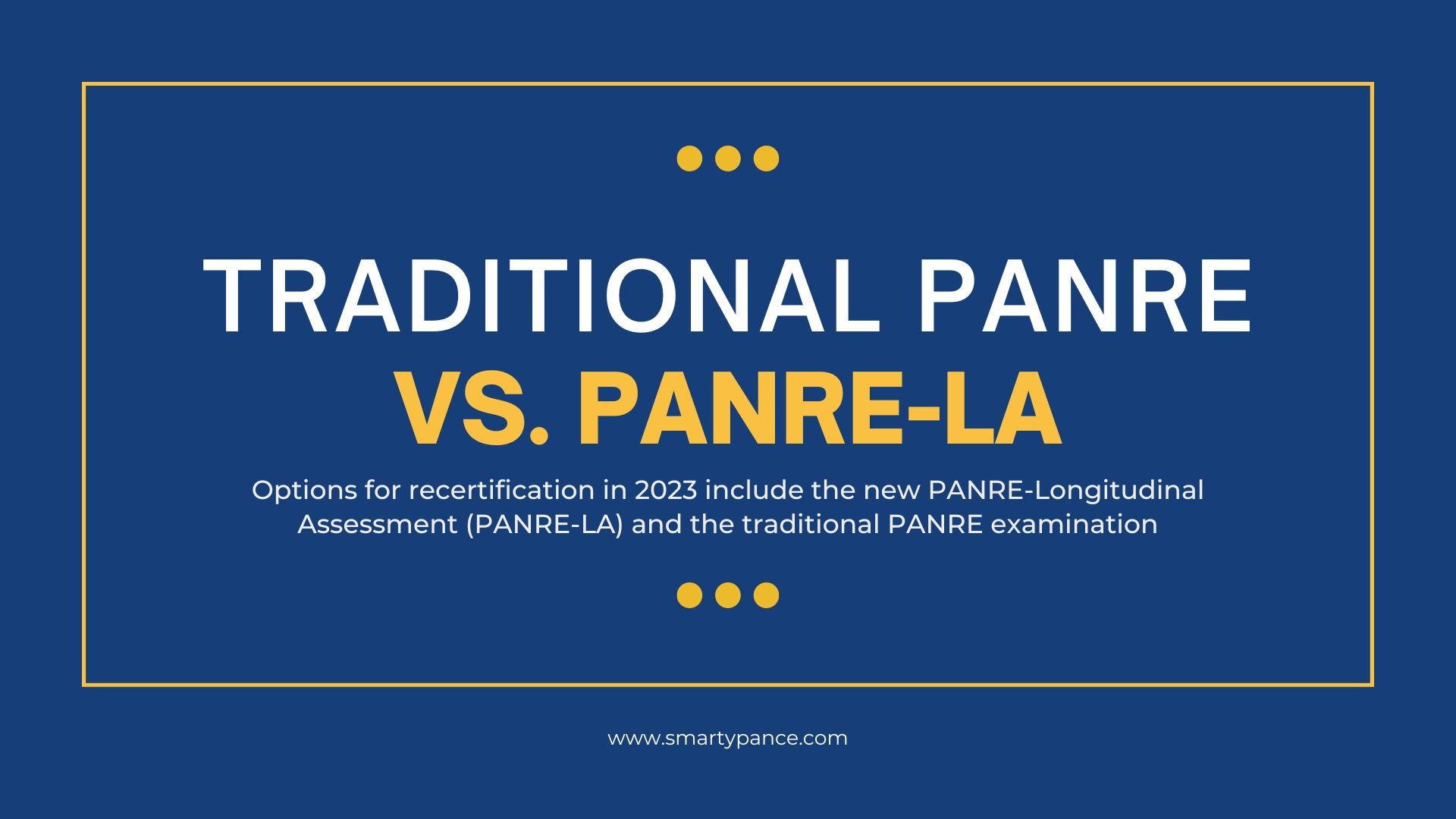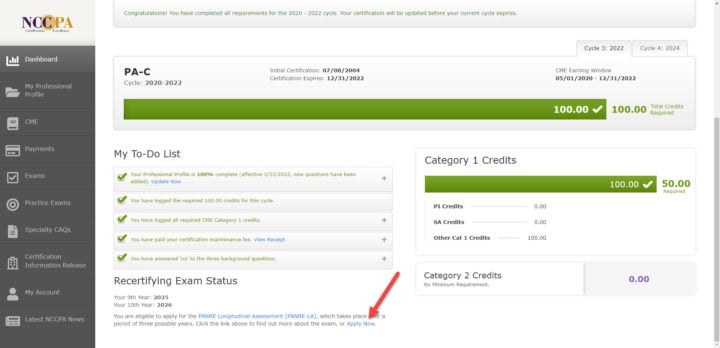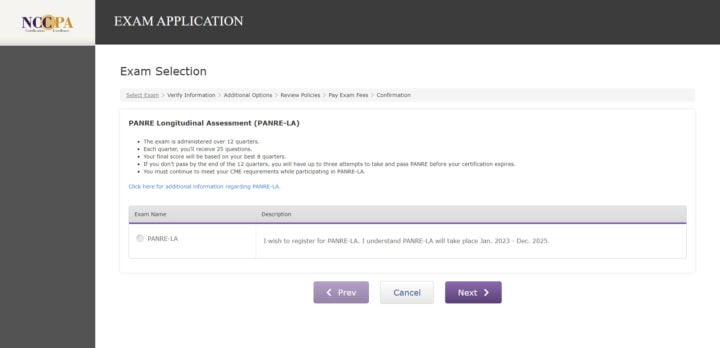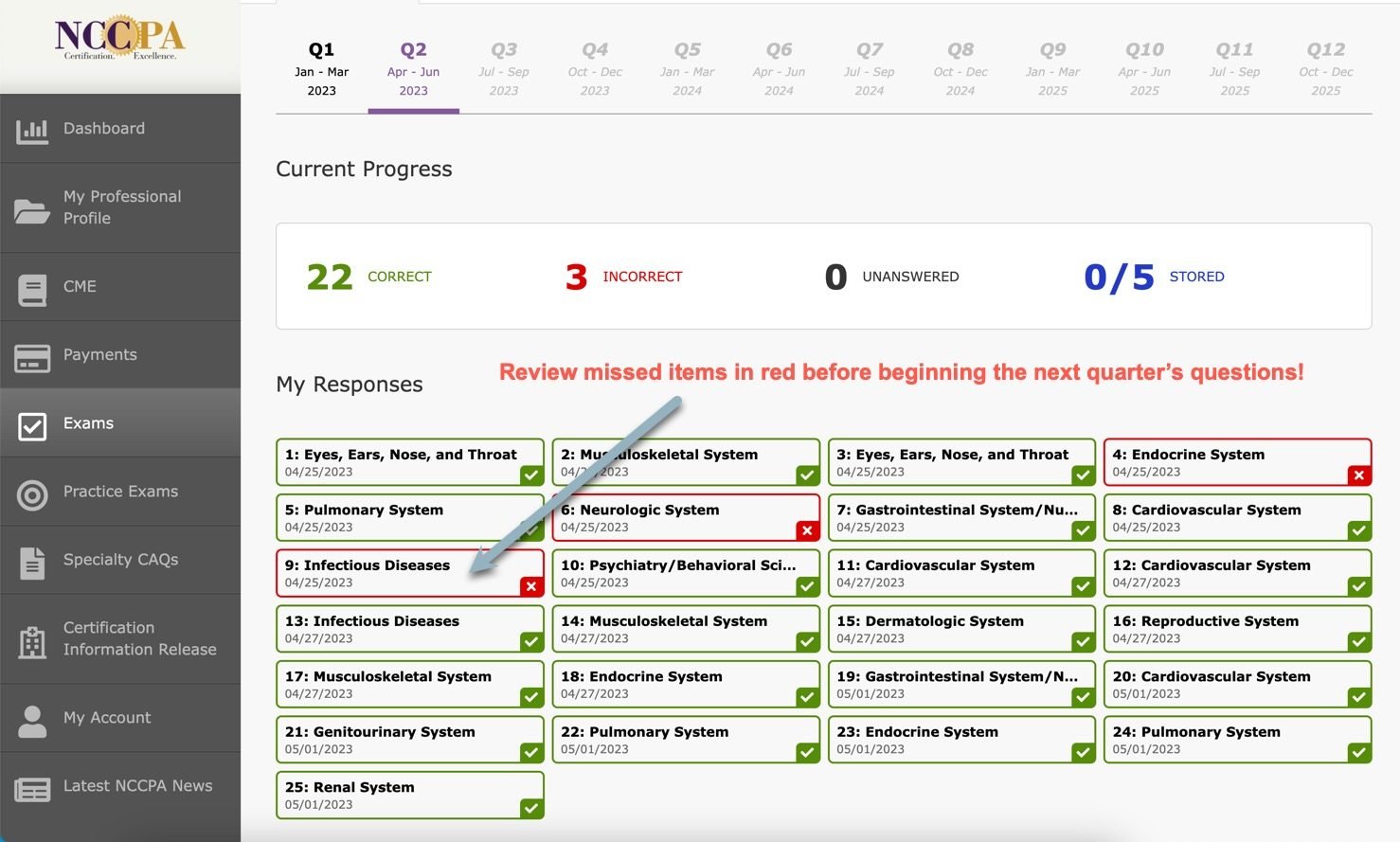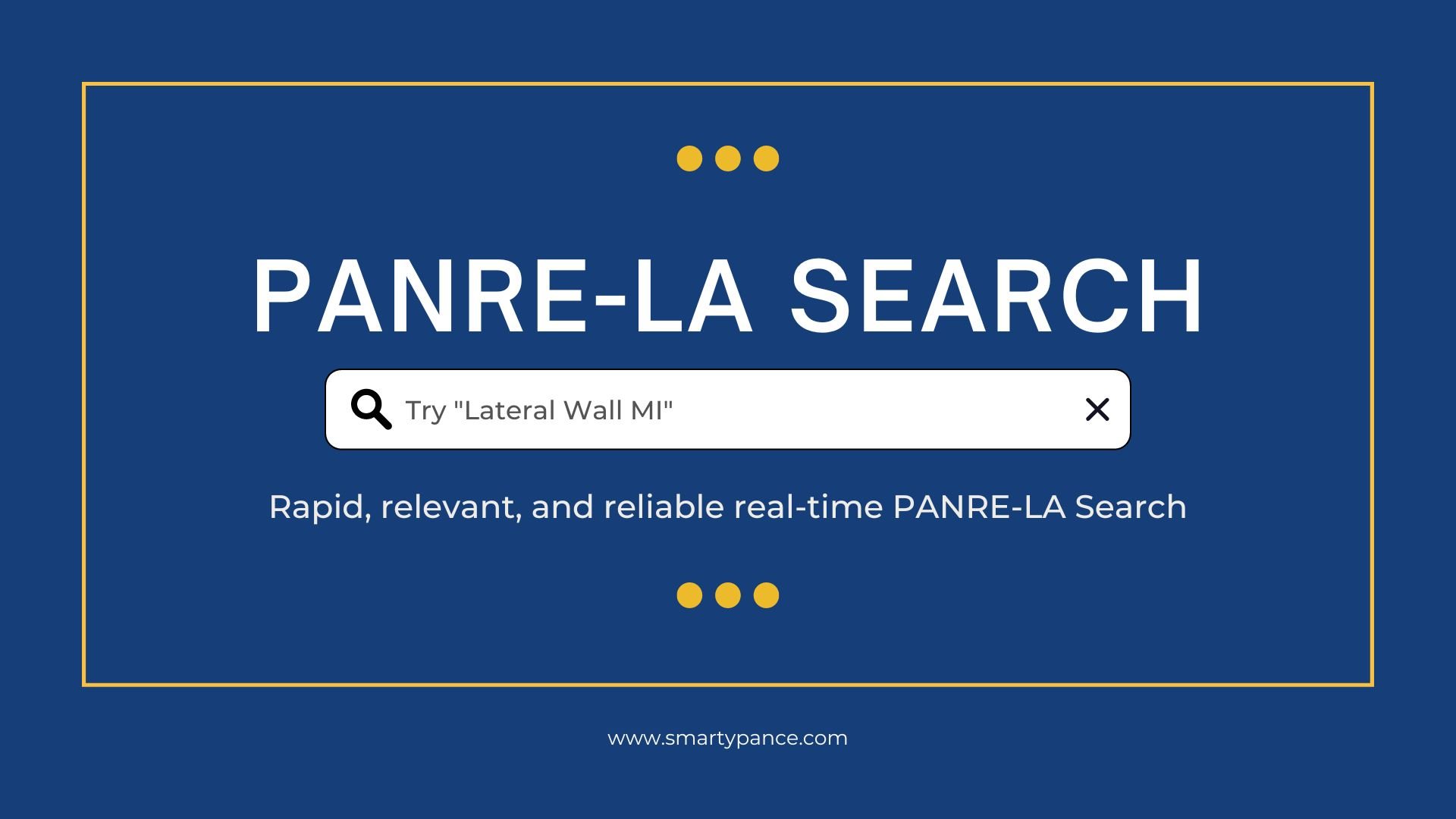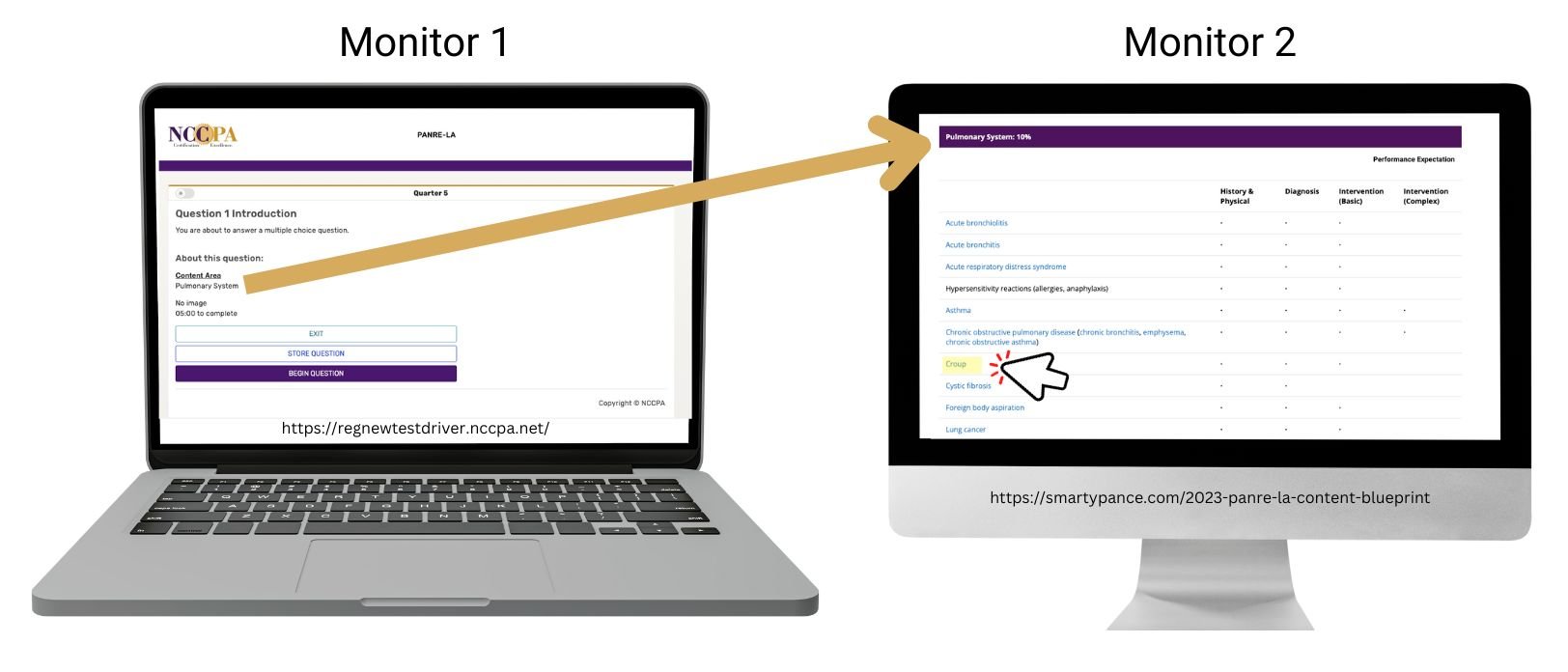The new PANRE and PANRE-LA exam for physician assistants has arrived! Are you prepared?
In this blog post, we discuss everything you need to know about the updated PANRE (traditional proctored exam) and the new PANRE-LA (in-home) exam. We first cover some history in addition to topics such as eligibility requirements, test format, the new PANRE blueprint, and study tips!
The New PANRE-LA Eam and Some PANRE Exam History
The PANRE-LA exam is a welcome alternative to the current (traditional proctored) PANRE exam. It comes after four years of research and a two-year pilot program that began in January 2019 and ran through December 2020, involving participation from approximately 18,000 PAs.
The PANRE-LA follows in the wake of a failed take-home PANRE examination option (The Pathway II) established in 1993 (retired in 2010).
Pathway II was offered as an at-home alternative to the proctored PANRE. Many PAs at the time were excited about a take-home recertification option, and I personally knew two PAs who took the Pathway II exam. Though the goal of Pathway II was to reduce the stress and time requirements of preparing for the traditional proctored PANRE exam, it was retired in 2010 as many who chose this route found it to be more burdensome than the traditional proctored exam.
Despite the relative failure (and retirement) of Pathway II, the NCCPA continued to search for ways to make the PANRE more "digestible" and accessible. The next significant (and welcomed) change to PA recertification came in 2014.
Since 1975, PAs have been required to take a recertification exam every six years. But as of 2014, the NCCPA extended the recertification requirement to a 10-year interval. As someone who completed two rounds of traditional proctored PANRE testing (2010 and 2016) under the six-year recert cycle, this was indeed a “life-altering” improvement!
A New (and Newer) PANRE Blueprint
The following notable change to the PANRE came in January of 2019 with the development of a new PANRE Blueprint specific to the PANRE aimed at assessing diseases and disorders considered part of a PA's core medical knowledge.
Before 2019, the PANCE and PANRE shared the same Blueprint - as of 2019, the PANRE got its own shiny new Blueprint, and the NCCPA introduced "assessment levels." The level 1-3 assessment designation was discontinued in December 2022 and replaced with a new PANRE Blueprint effective January 2023.
The new PANRE Blueprint ditches the antiquated assessment level designation in favor of four "performance expectation" categories, which include history and physical, diagnosis, intervention (basic), and intervention (complex).
All PANRE Blueprint topics require an understanding of history and physical along with the diagnosis. Most have a performance expectation of "intervention basic," but only a select few require the most complex performance expectation of "intervention complex."
The New PANRE Blueprint Layout
The NEW PANRE Blueprint (effective 2023) is remarkably similar to the current PANCE Blueprint. The PANRE Blueprint is based on fourteen organ systems with diseases/disorders corresponding to each organ system. Unlike the PANCE blueprint, the PANRE blueprint's diseases and disorders are not "nested" under what I will call a topic subheading.
An example of this would be the topic of "conduction disorders" in the PANCE cardiovascular system blueprint, which is laid out like this:
Conduction disorders/dysrhythmias
• Atrial fibrillation/flutter
• Atrioventricular block
• Bundle branch block
• Paroxysmal supraventricular tachycardia
• Premature Beats
• Sick sinus syndrome
• Sinus arrhythmia
• Torsades de pointes
• Ventricular fibrillation
• Ventricular tachycardia
In the new PANRE Blueprint, there is no topic of "conduction disorders," but the diseases and disorders are instead individually listed under the cardiovascular system heading - and if you look closely (as in the example above), there are fewer disorders included in the new PANRE blueprint.
This begs the question, "Should I know the PANCE disorders for my PANRE exam?" To which the answer should be no! But given the missing PANRE disorders under a topic such as conduction disorders/dysrhythmias, includes sick sinus syndrome, premature beats, and sinus arrhythmia, one could argue that these could somehow still be included in a PANRE question in a roundabout way.
The PANRE and PANRE-LA Blueprint Breakdown:
In total, there are 378 topics included in the PANRE/PANRE-LA Blueprint. They are broken up into four assessment levels. I have included the approximate number of topics in each performance expectation level. I have combined H&P + Diagnosis, as all topics that require knowledge of H&P also require knowledge of the diagnosis.
- History and Physical + Diagnosis (139 topics):
- History and physical: Given a stated/differential condition, the PA knows the associated signs, symptoms, history, and physical examination components, complications, risk factors for and risks caused by the stated/differential condition.
- Diagnosis: Given the signs, symptoms, history, risk factors, physical examination findings, and/or appropriate study results/interpretations, the PA is able to determine the most likely diagnosis.
- Intervention (Basic) (194 topics): The PA is able to manage a disease/disorder with a basic/straightforward presentation, including referral to a specialist, and complications of the management intervention.
- Intervention (Complex) (45 topics): The PA is able to manage a disease/disorder made complex by other factors and/or increasing in severity and complications of management or intervention.
Options for Recertification in 2024 Include the PANRE-Longitudinal Assessment (PANRE-LA) and the Traditional PANRE
Option 1: The Traditional Proctored PANRE Examination
The traditional proctored PANRE examination is similar to the PANCE exam, where you go to a secure testing center (Pearson Vue).
It consists of four blocks of sixty questions, with 60 minutes to complete each block. This means you have an average of one minute to answer each question. There is a total of 45 minutes allotted for breaks between blocks and 15 minutes to view a tutorial. The testing time is four hours, and the entire exam schedule is five hours.
You can "flag" questions you don't know for review and go back to them at any time while completing a 60-minute block. But when the time is up for that block, it's closed. This means any unanswered questions will remain unanswered. You NEVER want to leave a question unanswered - so as a side note, make sure you finish the block by answering ALL the questions - even if it means rolling the dice and making your best guess.
The traditional PANRE is about 20% shorter than the PANCE exam. The exam is delivered electronically, and students can choose to register from among hundreds of proctored test sites.
Option 2: The PANRE-Longitudinal Assessment (PANRE-LA)
FYI: This is the option I have chosen for my recertification.
Compared to the traditional PANRE examination, the PANRE-LA focuses on a few different ways of assessing your knowledge.
Like an extended-release formulation of many popular medications, "LA" is “long acting.” It stands for longitudinal assessments.
Instead of assessing things that you have learned, the PANRE-LA assesses for learning. Unlike the traditional PANRE (which assesses your knowledge at a given point in time), the PANRE-LA helps to identify if you, as a PA, can recognize and close gaps in your knowledge so that you can meet the standard of testing.
Instead of being assessed at one point in time, the assessment is dragged out a bit - over twelve quarters or three years. If you choose this option, you must participate in the exam questions for at least eight of the twelve quarters. If you get a passing score in the first eight quarters, you are all done! You don't have to take any more questions for the remaining four quarters or the remaining year.
There are twenty-five questions, and you have five minutes per question.
As a benefit, you don't have to complete all twenty-five questions in one sitting. You could answer a question here or there, or a few questions here or there, and then go back if you would like to. And because this type of recertification exam assesses your learning, you can use resources and material to look up things while taking the examination.
You are asked not to discuss the exam and its contents with others.
Keep in mind that if you have a quarter where you did not do well over the course of these twenty-five questions, you have four quarters as somewhat of a buffer. So, this type of test-taking is a lot more flexible. It's likely you won't need to take time off work or hide from family and friends to study. However, you will need to be in a quiet setting to complete the exam questions when the time comes.
Another benefit of the PANRE-LA option is that it has been approved for category one self-assessment CME credits by the AAPA. You will be rewarded three credits for every 25 questions completed. So, you get a little bit of extra CME to boot!
Here's some more information about the next steps you will need to take if you consider this option for recertification.
The PANRE-LA launched in January 2023. Certified PAs due for recertification in 2024, 2025, and 2026 were eligible for the 2023 initial launch of the PANRE-LA and must have applied between July 5th and November 30th, 2022.
- PAs due to recertify in 2028 can apply for PANRE-LA between July 1, 2024 – December 18, 2024
- PAs due to recertify in 2029 can apply for PANRE-LA between July 1, 2025 – December 18, 2025
Depending on when you are reading this article, you will have (or should have) received an email from the NCCPA when you are eligible to take the PANRE-LA exam.
Once the application process opens from July 1 to December 18, the deadline to apply and decide if you want to take the PANRE LA as an option is December 18'th 2024. So, keep that date in the back of your mind. If you miss the application period, you will be required to take the traditional PANRE.
To apply for PANRE-LA, sign into your online record at www.nccpa.net and select the “Apply Now” link in the Recertifying Exam Status section of your dashboard.
The fees for both the PANRE and the PANRE-LA are the same. At the time of this writing, they're both $350.
So, in review - usually, year six is when you would apply for PANRE-LA, and you will need to continue to maintain your CME requirements every two years.
Then, during years seven, eight, and nine, you will complete twenty-five questions per quarter (4 quarters per year). The NCCPA will score eight out of twelve quarters to determine a pass or fail decision. You will need a passing score in eight out of the twelve quarters.
This means year nine; if you have passed the first eight quarters, you will have both year nine and year ten of your recertification window as "open years." This means that if you pass the PANRE-LA, you don't need to do a gosh darn thing in your final two years of the recertification window.
If you haven’t passed after eight quarters, you can continue until the end of the last quarter, which still means year ten of the recertification window will be an "open year."
However, if you don’t pass your PANRE-LA, you will still have up to three attempts to take and pass the traditional PANRE. So, you don't have much to lose beyond the potential loss of $350 dollars by choosing the PANRE-LA option.
Below are the posted quarterly dates when PAs who are registered for PANRE-LA can log in to answer questions. The NCCPA will send email notifications when questions are available and when deadlines are approaching. Make sure to add these to your calendar.
- Remember: You must apply in the 6th year of your recertification cycle!
Application windows
- For PAs due to recertify in 2028: July 1, 2024 – December 18, 2024
- For PAs due to recertify in 2029: July 1, 2025 – December 18, 2025
Click here to add these dates to your Google Calendar
| 2024 | |
|
Quarter Starts |
Quarter Ends |
| Tuesday, January 2 | Monday, March 11 |
| Monday, April 1 | Monday, June 10 |
| Monday, July 1 | Tuesday, September 10 |
| Tuesday, October 1 | Tuesday, December 10 |
| 2025 | |
|
Quarter Starts |
Quarter Ends |
| Thursday, January 2 | Monday, March 10 |
| Tuesday, April 1 | Tuesday, June 10 |
| Tuesday, July 1 | Wednesday, September 10 |
| Wednesday, October 1 | Wednesday, December 10 |
How Many Questions Do You Have to Answer Correctly to Pass?
PANRE-LA, akin to proctored examinations, has a scoring system that adjusts based on the relative complexity of the questions posed to each PA. This implies that a static raw score or percentage isn't the benchmark for passing, as it will fluctuate for each participant based on the questions they encounter. Your final mark is calculated from your overall performance over a span of 8 to 12 quarters, indicating that it's not necessary to reach the passing standard every quarter.
Starting in the second quarter, 5 topics are repeated to reinforce existing knowledge and facilitate learning. In such instances, the better of the two responses is accounted for in the scoring, while the lesser response is disregarded.
This system offers chances to enhance your performance over a period. It's advisable to periodically review your "PANRE-LA Item History," giving particular focus to questions that were incorrectly answered.
What People Are Saying About the New PANRE-LA Exam
I have heard mixed feedback from PAs about which route they're planning to take - whether it's the traditional proctored PANRE or the new PANRE-LA.
Most practicing PAs in the recertification window lean toward the new PANRE-LA exam because it's more flexible, less anxiety-provoking, and (because you have 5 minutes per question) one can utilize resources during the exam.
However, many PAs still say that they don't want the recertification process to be dragged out for so long (for up to three years). They prefer to study hard, take a big, stressful test (so to speak), and just be done with it!
I personally have chosen to take the PANRE-LA exam and am glad I did. I recommend you do the same.
What Resources Should You Use During Your PANRE-LA Exam
As you may (or may not know), Smarty PANCE has a database of lessons with PEARLS covering all the PANRE and PANRE-LA topics. So, in preparation for the PANRE-LA, I built a search tool during the two-year pilot program to provide rapid results for search queries based on PANRE Blueprint topics.
I have personally used Smarty PANCE during my PANRE-LA exam and found it extremely helpful. You have 5 minutes to answer each PANRE-LA exam question - a small timeframe if you are searching through pages of text on UpToDate, but plenty of time to make a quick search query in the Smarty PANCE PANRE search tool for something like treatments or lab finding for a topic such as "bacterial prostatitis."
The search tool provides a quick list of results in bold (and highlighted by your search term) from only the PANRE-LA lessons, so you can scan the results quickly to find an answer you may be looking for.
Another (and my preferred option) is to use the general search tool in the admin bar of the Smarty PANCE website. Since each question of the PANRE-LA is referenced by organ system, doing a search of diagnosis within your differential and opening corresponding lessons on Smarty PANCE is extremely likely to lead you to the correct answer. And, since each Smarty PANCE lesson is linked to corresponding Merck and UpToDate references, you can do additional homework quickly without having to perform an additional search.
I highly recommend using a dual monitor setup. This could be a laptop/monitor or desktop multi-monitor setup (FYI: I use an M2 Mac Mini connected to three monitors.)
- I keep one monitor open with the PANRE exam question I am answering.
- The second monitor I have opened with the content area specified by the question.
Before answering the question, you are provided with the content area. As in the example above, I know the exam question is going to be about the pulmonary system. I then open the corresponding content area on Smarty PANCE. I quickly look through the potential topics I can be tested on). If there are topics you want to brush up on quickly, click on a link in the content area for a quick review. Once I begin the question, I reference this to the Smarty PANCE content area to narrow my differential, then click the link to the topic. In the example above, I have “croup” highlighted, which would correspond to a question I feel is related to croup. I would then click that lesson link.
I have been using additional resources during my PANRE-LA exam that provide quick, searchable, bulleted summaries of many PANRE-LA topics, including the Merck Manual, UpToDate, and Family Practice Notebook. I have also found answers to questions by performing a basic Google search along with AI tools such as Gemini (by Google) and ChatGPT (though be careful, the results here are mixed).
If there is a reference you have used (or plan to use), let us know in our Smarty PANCE Member's Community!
References and resources:
- The Smarty PANCE PANRE-LA Search Tool
- Smarty PANCE PANRE/PANRE-LA Interactive Content Blueprint
- NCCPA Certification Maintenance (resource page)
- NCCPA PANRE/PANRE-LA content Blueprint by Category
- NCCPA PANRE/PANRE-LA Content Blueprint
- What to Know About the New PANRE Alternative Opportunity as a Future PA (Be a Physician Assistant Blog)
- Podcast: An Update on PANRE-LA, the New Recertification Exam Alternative for PAs
- NCCPA Insights Podcasts: All about the PANRE-LA



